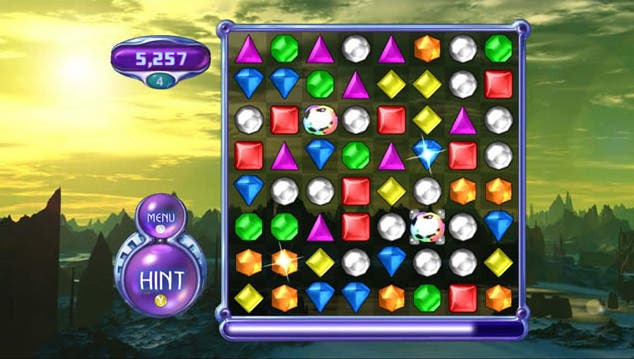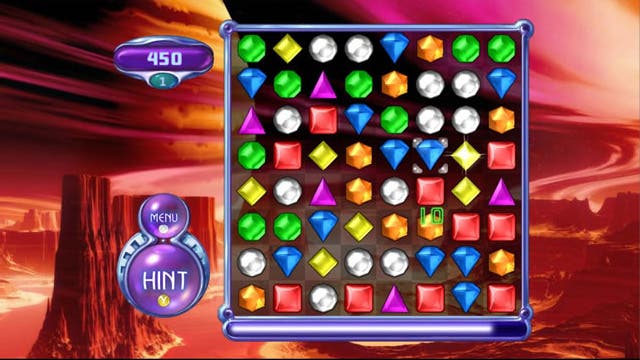Bejeweled 2
Officially not as good as Zoo Keeper.
How many hours did you lose to Zoo Keeper last year? 10? 20? 100? Who's even counting? Maybe you're still playing it in lunch breaks and on commutes, busily trying to conquer all the modes so you can finally get a Time Attack score worthy of the name. Famously, it's the only game in Eurogamer's history that the same reviewer has felt the need to re-assess because the penny soon dropped that something this addictive deserved better than its initial score. Initial impression of it being little more than an overpriced, subtle reworking of Bejeweled (in itself a free Flash game) were swept away. It was one of the few games that almost seemed made for the DS' touch screen, and even now we're unlikely to leave home without it. Quite how it could translate to a joypad we had immediate concerns about, though.
As a game concept, Bejeweled is absolute unadulterated, unquestionable, mind-bending genius. In terms of puzzle greatness, it's probably the only game to rival Tetris for its stultifying, obsessively addictive qualities and maddening brilliance. Once you start switching those tiles around and matching up colour, it's pretty unlikely you'll ever be able to stop. That's EVER. Be warned.
Explaining it to newcomers never sounds that exciting, but bear with us. Based on an eight by eight grid, the game amounts to little more than frantically scouring said grid in order to match three or more of a kind by switching adjacent tiles (or in this case, gems) around horizontally or vertically. As lines of three or more match up the gems explodes, so new ones rain down from the top of the screen to fill the breach, often setting off chain reactions and high scoring bonanzas into the bargain.
Three, the magic number

But it's never as simple as it looks. Just matching up three of a kind won't get you very far, as you really need to work out tactics to help you build up the points that will fill the progress bar that will get you onto the next level. Four of a kind (or creating an 'L' shape of identical gems), meanwhile, leaves one gem behind that explodes when matched with the appropriate colour, taking out all those in its immediate blast radius, and setting off chain reactions in its wake. Five of a kind, though, is really where it's at, allowing you generate a Hyper Cube to wipe out all gems on the grid of any coloured gem adjacent to it, but hetting these in the first place requires either a lot of determination, or a slice of luck.
The big points, though, come through setting off chain reactions, and these are again, often down to the luck of the draw, but if you're good enough at the game you can sometimes see them coming far enough in advance to make your own luck. If you can pull these off, then progression in the game will be so much easier.
Depending on which mode you're playing, the premise will be slightly altered, with , for example, Action mode tasking you with a brutally ticking time limit, while others give you as long as you like (such as Classic and Endless modes) but dish out the Game Over screen if you no longer have any moves left. In this deluxe version, there's even a few other variations on the theme, such as the Puzzle mode, which presents you with 80 levels of brain-teasing arrangements of blocks to try and clear up one by one, at your own pace, and complete with hints if you need them.
The shape of things

Four 'Mystery' modes remain locked away for the really advanced (and we do mean stupidly advanced) players to scalp, but are little more than variations on the rather excellent theme. Cognito mode (by far the easiest to unlock), for example, amounts to little more than a score-based take on the Puzzle mode, complete with the exact same levels all over again, but without the Galaxy 'hub' to choose levels from. Twilight, Hyper and Finity mode await... but the chances are you'll have to work harder than you'd expect to find them. A word to the wise: moving clockwise about seven times in succession around the mode select menu unlocks the 'original' Bejeweled mode, for what it's worth.
To unlock those and in turn the achievements in the game requires an ungodly amount of skill that, frankly, would elude all but the top players in the entire world. Completing 280 levels of Endless mode is insanity, while reaching level 17 in classic mode and level eight in Timed is brutally difficult without being enormously good at the game, requiring the reflexes of a cat, nerves of steel and the kind of luck that would suggest you should take up gambling. If you can scalp an 8x cascade or make 1000 Hyper Cubes, you're a better (or jammier) man than I...
But what ultimately takes some of the gloss off Bejeweled 2 isn't so much the overly harsh conditions required to earn achievements or unlock the extras, but the limitations of the control pad itself. Unlike the original PC version, or Zoo Keeper on the DS, you can't be as instant and intuitive when you're moving a cursor around the screen. It's simply not as responsive or precise as a mouse or a touch screen, meaning precious seconds are lost while you rapidly fumble around the play area. It's not a complete deal-breaker, but it's simply not as enjoyable playing the game this way, and by the time things get more advanced, more demanding and hectic, you'll curse the inability to make super-quick manoeuvres.
Admittedly, at 800 points (roughly £6.66) it's way way cheaper to buy Bejeweled 2 on Xbox Live Arcade than it is to go out and buy Zoo Keeper, but it's also not in the same league of fun. If you don't have a DS, then we 'd definitely urge you to go and download the free demo from Live Arcade, but whether you'd want to buy it depends largely on how well you get on with using a joypad to control a game that wasn't really designed that way.


